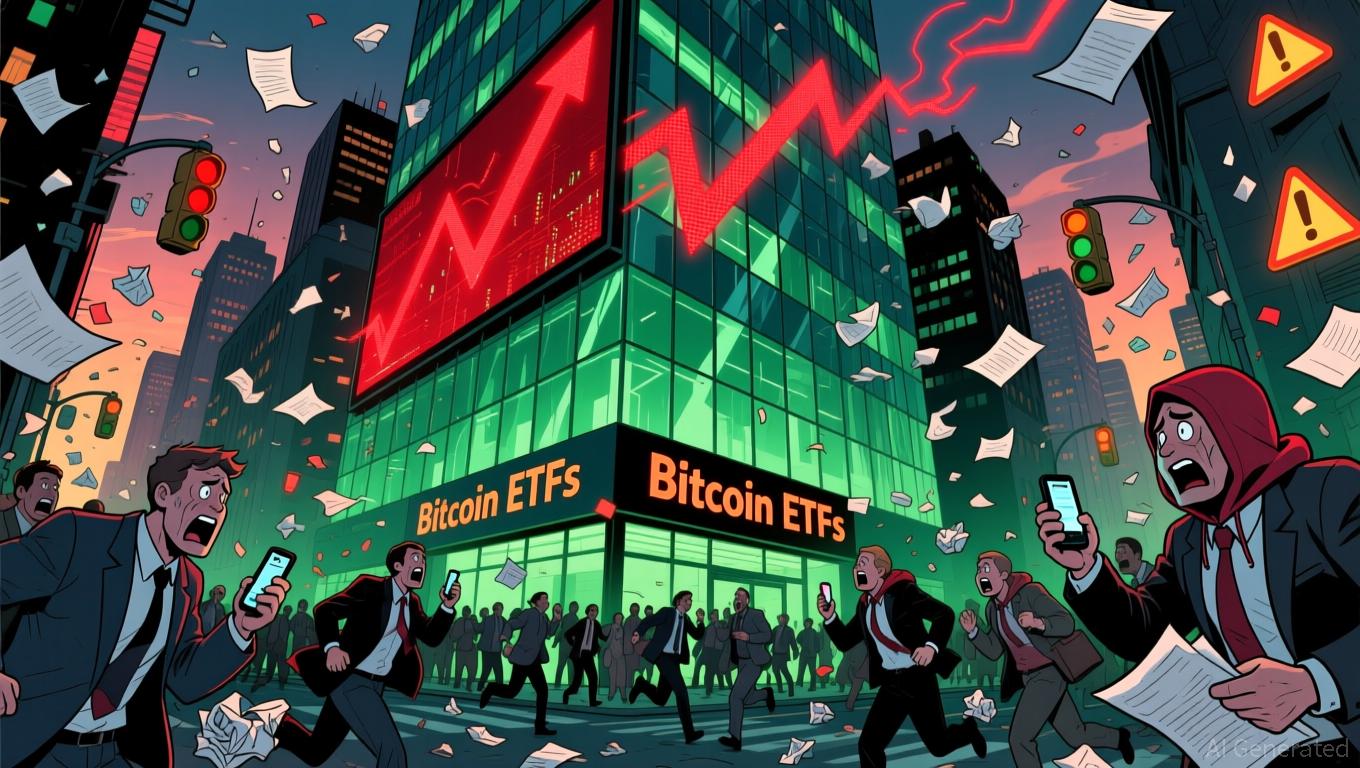Bitcoin’s Rapid Uptake by Institutions in November 2025: Key Opportunities for Retail Investors in the Face of Favorable Macroeconomic Trends
- 2025年比特币机构采用加速,监管明确(如现货ETF获批)和基础设施完善(如BlackRock IBIT、JPMorgan托管服务)推动资本流入。 - 美联储转向量化宽松及降息至3.75%-4%,叠加政府停摆结束带来的流动性,强化比特币作为风险资产的吸引力。 - 技术指标显示比特币RSI超卖(30.52)且MACD趋平,机构ETF资金流出现反弹(如IBIT单日流入7547万美元),暗示短期修正可能。 - 散户投资者可关注9万美元关键支撑位及ETF资金流向,结合宏观宽松与机构动向把握战略入场时机,但需警惕HODL/FBTC等基金的持续看空信号。
Regulatory Clarity and Institutional Infrastructure
In 2025, the U.S. regulatory environment for Bitcoin advanced considerably, with the green light for spot Bitcoin ETFs becoming a key driver for institutional participation. BlackRock's iShares Bitcoin Trust (IBIT) has been central to this progress, though its recent
At the same time, leading financial firms like J.P. Morgan, Bank of America, and BNY Mellon have
Macroeconomic Tailwinds and Fed Policy Shifts
The Federal Reserve’s policy direction at the end of 2025 has provided a supportive environment for Bitcoin. In December 2025,
Fiscal policy has further strengthened these positive trends.
Technical Indicators and Institutional Buying Signals
Technical analysis of Bitcoin in late 2025 points to a possible short-term turnaround.
There are also signs that institutional buying is stabilizing. After five consecutive days of outflows totaling $1.43 billion,
Strategic Entry Points for Retail Investors
For individual investors, these combined factors create a complex but promising entry scenario. The current technical picture—oversold RSI, steadying MACD, and renewed institutional inflows—points to a possible accumulation area near $90,000. Retail investors should keep a close eye on critical price levels: a sustained move above $95,000 could open the door to retesting the October peak at $126,080, while failing to hold $90,000 might prolong the correction.
On the economic front, the Fed’s adoption of QE and increased private sector liquidity are tailwinds for risk assets. Retail investors should also monitor further institutional investments in ETFs like IBIT, as these could signal a broader return to Bitcoin. Still, caution is advised: bearish sentiment persists in funds such as VanEck’s HODL and Fidelity’s FBTC, indicating ongoing skepticism about a full market rebound.
Conclusion
In late 2025, Bitcoin’s institutional journey is shaped by both regulatory advancements and economic uncertainty. Although recent outflows and volatility have challenged confidence, the foundational infrastructure and institutional interest remain strong. For retail investors, the mix of technical signals, central bank policy changes, and strategic institutional buying presents a persuasive argument for selective market entry. By focusing on vital support zones, tracking ETF activity, and staying aligned with broader economic trends, retail investors can better position themselves to benefit from Bitcoin’s next growth phase.
Disclaimer: The content of this article solely reflects the author's opinion and does not represent the platform in any capacity. This article is not intended to serve as a reference for making investment decisions.
You may also like
Bitcoin Updates: ETF Outflows Push Bitcoin to Lowest Point in Seven Months Amid Market Turmoil
- Bitcoin fell below $83,400, its lowest in seven months, as U.S. spot ETFs saw $3.79B in November outflows, led by BlackRock’s $2.47B loss. - Record $903M single-day ETF redemptions accelerated crypto and equity market selloffs, with Nvidia and crypto stocks dropping sharply. - Ethereum ETFs lost $1.79B, while altcoin funds like Bitwise’s XRP gained $105M, reflecting shifting investor preferences amid liquidity concerns. - Analysts attribute the selloff to macroeconomic uncertainty and delayed Fed rate cu

Dogecoin News Today: Grayscale DOGE ETF Debut May Trigger a Wave of Institutional Interest This November
- Grayscale's DOGE ETF launches Nov 24, aiming to boost institutional adoption of the meme coin amid SEC approval. - BlockDAG's $436M+ presale outpaces ADA/BCH, leveraging hybrid PoW-DAG tech and 3.5M miners to attract 312K holders. - Ethereum faces $2,850 support pressure after FG Nexus sells 11,000 ETH, triggering $170M in 24-hour liquidations. - DOGE hovers near $0.15 support with mixed technical signals, while ETF optimism contrasts with ongoing distribution trends.

ZK Atlas Enhancement: Leading the Way in Blockchain Expansion and Enterprise Integration
- ZKsync's 2025 Atlas Upgrade resolves blockchain scalability trilemma via modular architecture, achieving 15,000–43,000 TPS with 1–500ms finality. - Institutions like Deutsche Bank adopt ZKsync for cross-chain settlements, while TVL in ZK ecosystems hits $3.5B and ZK token price rises 50%. - Compliance features and EVM compatibility address institutional needs, with $15B in Bitcoin ETF inflows accelerating adoption of tokenized assets and RWAs. - Analysts project 60.7% CAGR for ZK Layer-2 solutions throug
ZK Technologies' Price Soars: The Intersection of Major Scalability Advances and Growing Institutional Interest
- ZK Technologies surged to $0.085–$0.090 in late 2025, driven by ZK rollup innovations and institutional adoption. - ZK rollups achieved 15,000 TPS by October 2025, with Ethereum's EVM optimization reducing proof costs 50-fold. - Deutsche Bank , Sony , and Citibank adopted ZK-rollups for confidential settlements and cost-efficient transactions. - Deflationary token model and fee buybacks increased scarcity, driving demand and value accrual. - ZK-based solutions now address scalability and privacy, becomin